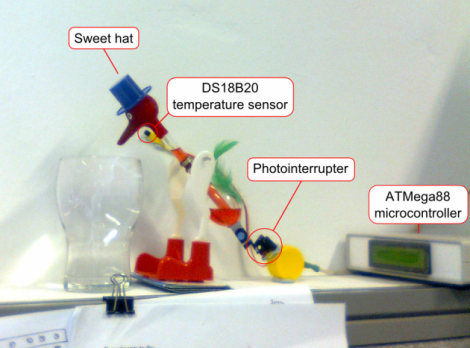
Dippy birds are the toys that teeter-totter back and forth as the beak of bird-shaped body dips into a container of water. The felt covering the beak and head picks up water and, through evaporation, cools that end of the glass tubing. The temperature changes cause the dichloromethane to either boil off, or condense, shifting the weight of the liquid thereby pivoting the glass body.
The real question is, does the temperature of the water cause the toy to move differently, and can that be measured to calculate the temperature of the water? [Craig] put that query to the test, by designing an apparatus to measure the motion of a Dippy Bird. A photointerruptor was used to measure the motion of the body, causing an interrupt each time the tail of the bird passes in between the sensor and the emitter. For control data a DS1820 temperature sensor was positioned near the felt on the head of the bird, and a relative humidity sensor captured readings at the same time. Data from the three inputs was collected over a two-day period. Although not a precise measurement, the motion of the bird did trend in the same ways that were recorded by the temperature and relative humidity sensors.















This post made me realize that passive solar array movers and dippy birds are the same technology.
That is really cool.
Hmm… I’m now envisaging 1000’s of these Dippy birds out in a lake each set 1/100th of a second out of phase with a small neodinium magnet and coil set up to collect a few mA from each :D
And the sound of them all clinking on their glasses would be deafening!
and you didn’t use the press release?
Rube Goldberg FTW!
@Will:
No Rube Goldberg in this project. The author had a theory and devised a way to test his theory automatically without having to stand there all day collecting data points.
it’s not just the temperature that determines how fast the felt dries again. it’s also the relative humidity (google “wet bulb”)
Always remember: It is very dangerous to use your dipping bird to vent radioactive gas.
Now this is my kind of OCD!